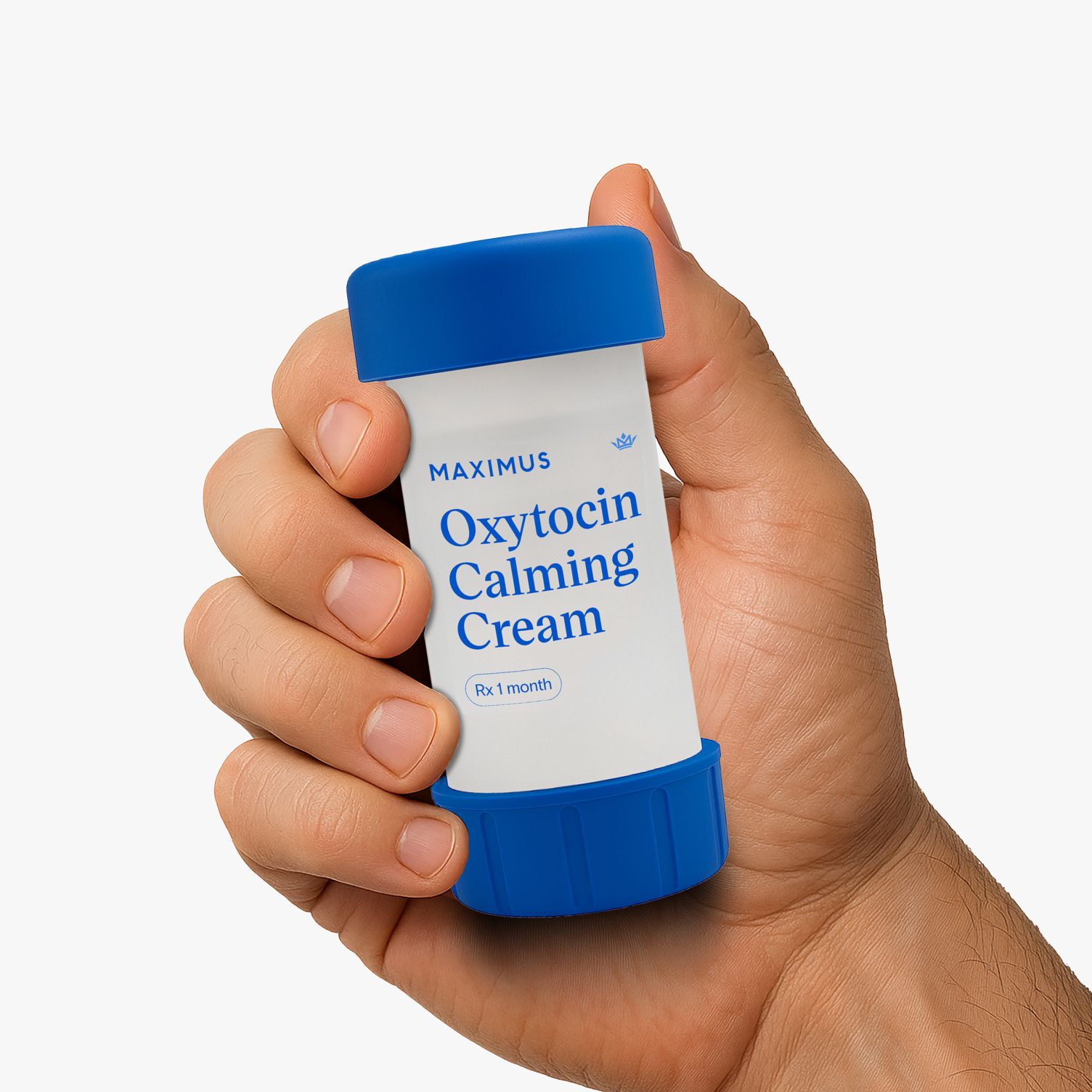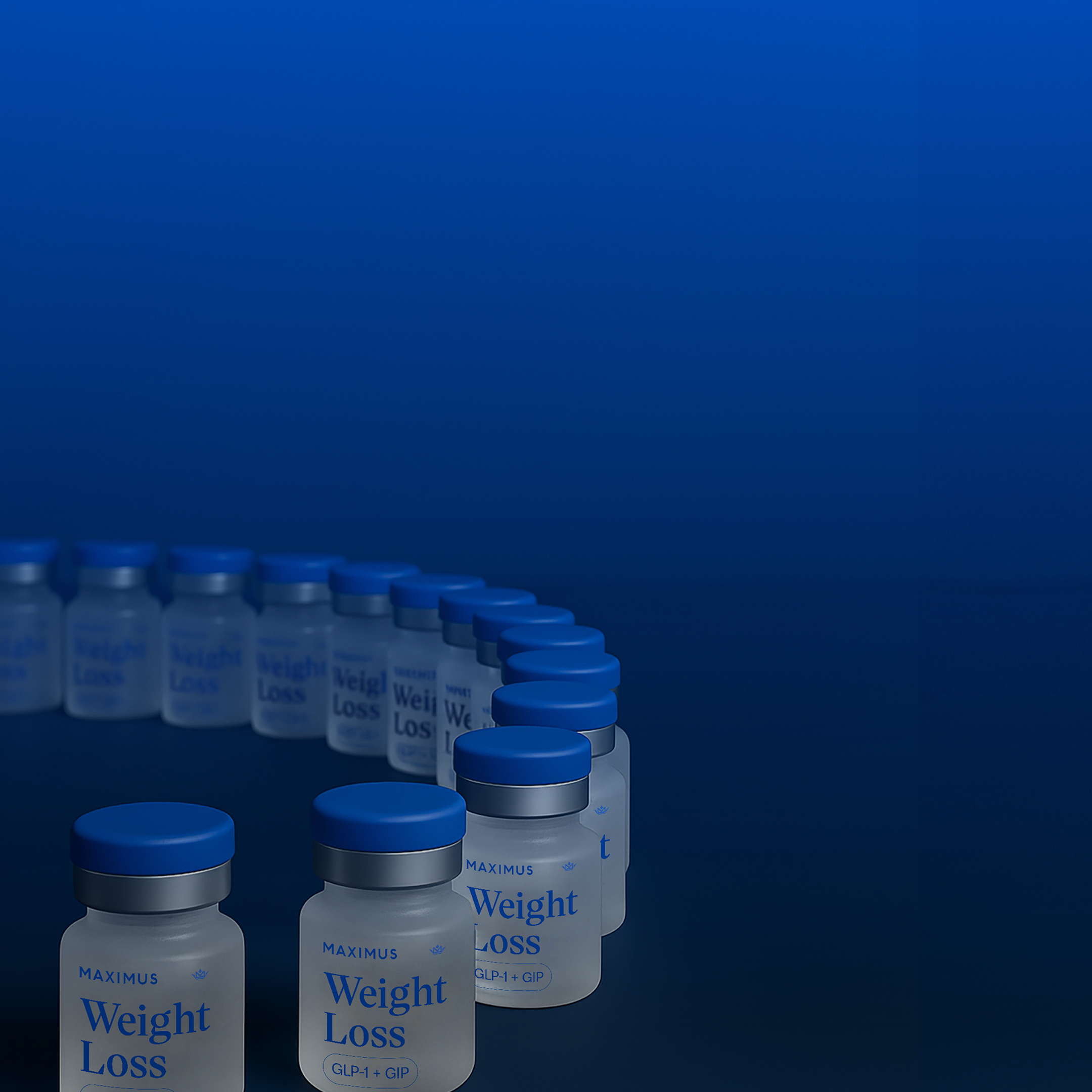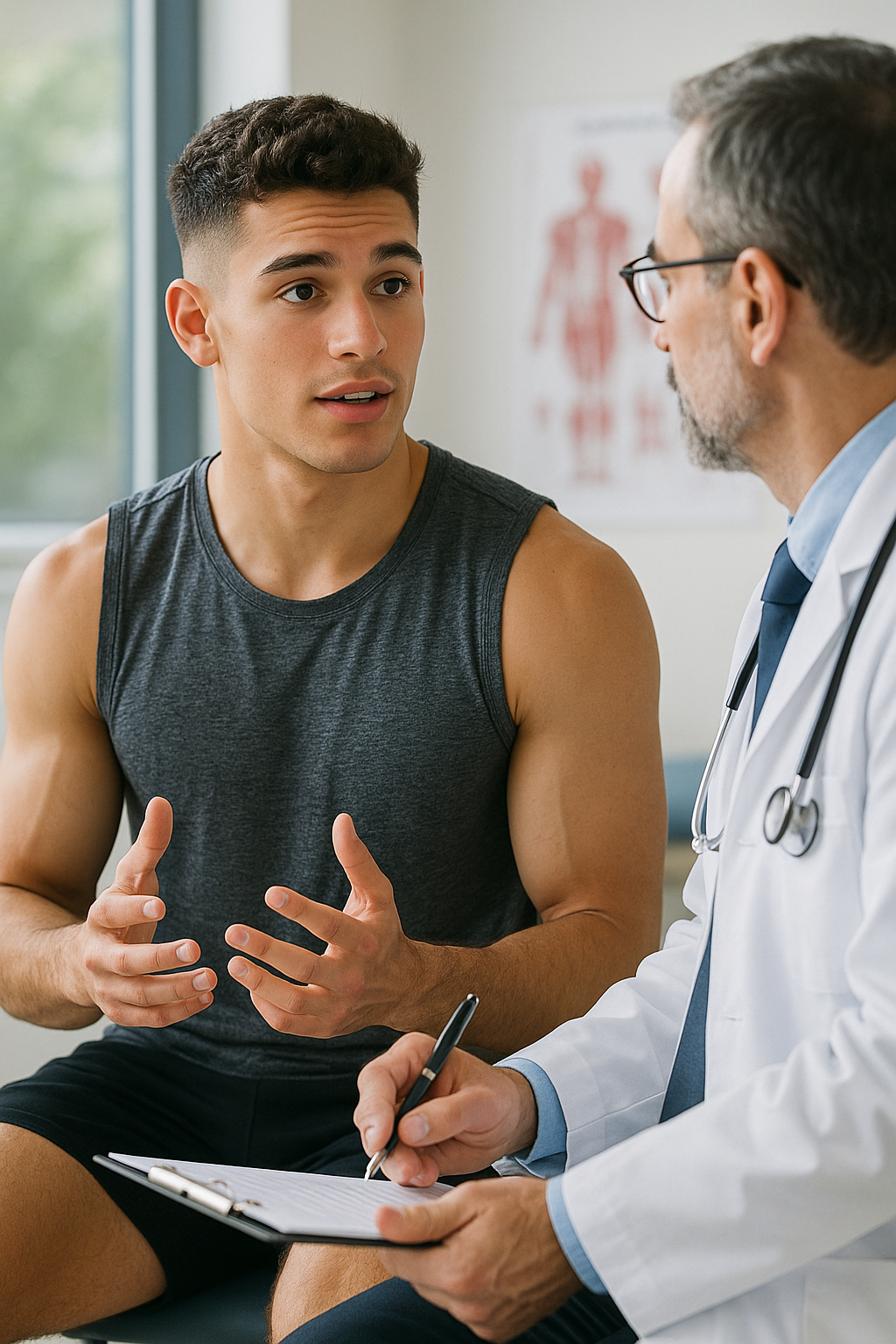Your buddy just told you he’s taking testosterone replacement therapy (TRT) and you’ve got one question in your mind: Should I be taking it too?
The thing is, you’re only 29. Can TRT be safe and effective for you too? More and more younger men, even those in their 20s, are starting to ask this question.
If you're navigating brain fog, low sex drive, or unexplained fatigue, low testosterone could be playing a role. Below, we’ll walk you through what the research says about taking TRT and how to approach the conversation with your doctor.
How common is low testosterone in your 20s?
According to research presented at the 2020 American Urological Association Virtual Experience, around 20% of men ages 15-39 have a testosterone deficiency. As for why this is happening, researchers aren’t entirely sure but pointed to some potential causes like obesity and increased body mass index (BMI), diet, lower levels of exercise, environmental exposures, stress, underlying medical conditions, and marijuana use.
Here’s a bit more information on some of these factors that can contribute to reduced testosterone levels:
Environmental exposures
Exposure to endocrine disruptors like phthalates, bisphenol A (BPA), and polyfluoroalkyl substances (PFAS) can interfere with hormonal systems. These substances can mimic or block hormones and disrupt normal bodily functions. Research has linked exposure to endocrine-disrupting chemicals with decreased testosterone levels and impaired reproductive health in men.
Poor sleep
Chronic sleep deprivation can negatively impact testosterone levels. Studies show that restricting sleep to five hours per night for one week can reduce daytime testosterone levels by 10–15% in young healthy men.
Overweight or obesity
Research shows that obesity is a leading factor associated with low testosterone. Excess body fat can increase the conversion (aromatization) of testosterone to estrogen, leading to lower total and free testosterone. Weight loss can help restore testosterone levels in obese individuals, research shows.
Alcohol and drug use
Certain substances can disrupt the body’s normal hormone production. Heavy alcohol use, opioids, and anabolic-androgenic steroids can interfere with communication between the brain and testes, contributing to lower testosterone levels, research shows.
Substances like nicotine, cannabis, and amphetamines can affect sperm production and contribute to a hormonal imbalance by promoting oxidative stress and impairing testicular function.
Overtraining
While regular physical activity can support hormonal health, excessive endurance training without adequate recovery can lead to a condition known as the exercise hypogonadal male condition (EHMC).
EHMC has been seen in athletes who participate in prolonged, high-volume endurance activities like long-distance running, cycling, and swimming. It can occur particularly when combined with insufficient caloric intake, although intense training alone can also suppress testosterone levels.
Studies have found that some men involved in intensive endurance training may have significantly lower resting testosterone levels, sometimes only 50–85% of those found without EHMC.
Stress
Chronic stress can suppress testosterone production. Elevated cortisol levels can inhibit the hypothalamic-pituitary-gonadal (HPG) axis, leading to decreased testosterone synthesis over time. Managing stress through healthy lifestyle habits like sleep, exercise, and mindfulness can help protect hormonal balance.
Other medical conditions
This could include diseases, tumors, or disorders related to the hypothalamic or pituitary glands in the brain, testicle injuries, testicular tumors, diabetes, liver disease, AIDS, and cancer treatments. Inherited conditions like Down syndrome, Prader-Willi syndrome, Kallman’s syndrome, or Klinefelter syndrome can all cause low testosterone.
Can young men safely take testosterone?
Men under 40 can take testosterone replacement therapy (TRT) — if there’s a legitimate medical reason for it.
If someone is diagnosed with a medical condition that causes low testosterone, TRT can lead to changes like improved energy, motivation, sexual health, and muscle strength.
The key is seeking a full medical evaluation before starting therapy. Using testosterone without a confirmed hormonal deficiency or without symptoms of low testosterone is not recommended by physicians. Without proper consultation and supervision, TRT can lead to unwanted side effects — and, at worst, serious complications.
Testosterone therapy and fertility: What young men need to know
Younger men considering TRT should be aware that testosterone therapy can suppress sperm production and may affect fertility. For those who want to maintain fertility, alternative approaches, such as enclomiphene, may be recommended.
Exogenous testosterone suppresses the hypothalamic-pituitary-gonadal (HPG) axis, leading to a decrease in the secretion of luteinizing hormone (LH) and follicle-stimulating hormone (FSH), both of which are critical for stimulating the testes to produce testosterone and sperm. As a result, sperm production can dramatically decrease or even cease entirely while on TRT.
The degree of fertility suppression depends on factors like the duration of therapy and the dose administered. In many cases, sperm production begins to recover within 3 to 6 months after stopping TRT, but full recovery can take up to 12 to 24 months, and isn’t guaranteed for all individuals.
To mitigate these effects, men who are looking to preserve fertility may consider alternative treatments such as enclomiphene, a selective estrogen receptor modulator (SERM), that stimulates endogenous testosterone production while maintaining spermatogenesis.
Enclomiphene: A fertility-friendly alternative
Enclomiphene is an alternative to traditional testosterone therapy for men who are looking to address low testosterone symptoms while also maintaining their fertility.
Unlike exogenous testosterone, which suppresses the HPG axis, enclomiphene stimulates endogenous testosterone production.
Enclomiphene is a selective estrogen receptor modulator (SERM). It blocks estrogen receptors in the hypothalamus, which increases the release of gonadotropin-releasing hormone (GnRH). This, in turn, boosts LH and FSH levels, promoting the body’s natural testosterone and sperm production.
Clinical trials have shown that enclomiphene can increase serum testosterone levels while maintaining sperm parameters in men with secondary hypogonadism.
Diagnosing low testosterone: What to expect
Diagnosing low testosterone requires a full picture of your health, including your symptoms, medical history, and bloodwork.
If you’re noticing signs of low testosterone like low energy, poor focus, stubborn fat, or a drop in drive, a comprehensive blood test is a useful first step toward understanding your hormone health and potentially improving your testosterone levels. At Maximus, we test your total and free testosterone, SHBG, LH, FSH, and more to give you a comprehensive picture of your hormone health.
Here’s what to expect:
Clinical evaluation
Doctors typically begin by asking about how you’re feeling and going over your medical history. They may ask about symptoms such as low sex drive, fatigue, mood swings, poor concentration, weight gain, and muscle loss.
Blood testing: total testosterone
This is the standard test for assessing overall hormone levels.Testosterone levels change during the day, peaking in the morning and gradually declining throughout the day. For an accurate reflection of your peak levels, aim to schedule your testosterone test for the morning between 7 and 10 AM. You might need more than one blood draw to confirm your results.
Blood testing: luteinizing hormone (LH) and follicle-stimulating hormone (FSH)
Testing LH and FSH levels can help determine the origin of testosterone deficiency. Elevated levels suggest primary hypogonadism, meaning the low testosterone originates in the testes. Low levels of FSH and LH, along with low testosterone, can indicate secondary hypogonadism, meaning the low testosterone is due to the pituitary gland or hypothalamus in your brain.
Blood testing: free testosterone and sex hormone-binding globulin (SHBG)
Free testosterone and SHBG tests provide further insight into your hormone health.
While total testosterone gives you the big picture, it doesn’t tell you how much of it your body can use. That’s where free testosterone and SHBG come in. SHBG binds to testosterone and limits how much is actually available for your body to use.
Free testosterone, which makes up 1-2% of all testosterone in the body, is what your body uses for things like muscle growth, libido, and overall energy levels.
By measuring free testosterone and SHBG, your doctor can get a better understanding of your hormone balance and whether your symptoms are tied to low bioavailable testosterone.
Additional lab tests
Tests for hemoglobin A1C, alanine aminotransferase (ALT), and prostate-specific antigen (PSA) can provide a more complete picture of your health and inform your doctor on the best course of action to treat any hormonal imbalances that exist.
How to talk to your doctor about low testosterone
If you’re feeling off and have been noticing persistent symptoms of low testosterone, It's worth having a real conversation with your doctor. Here’s a simple way to prepare so you feel confident walking in (or logging in).
Make some notes about:
- Symptoms: How’s your energy throughout the day? Are you feeling sharp and focused, or foggy and drained? What about your mood, sleep quality, sex drive, or motivation? Don’t dismiss any symptoms — even the little things can sometimes point to bigger patterns.
- Lifestyle: Take a snapshot of your daily routine. How’s your diet? Are you drinking more than usual? What’s your stress level like? Are you getting regular workouts or feeling too wiped to move? And don’t forget to list any supplements or medications you’re taking.
- Goals: What’s the bigger picture here? Are you hoping to have kids in the near future? Trying to bounce back from burnout or illness? Wanting to feel like your old self again — or better? These goals will shape the kind of treatment plan that makes sense for you.
Be honest. And don’t hesitate to ask for a second opinion if something doesn’t feel right. The goal is to find a treatment that works for your body, not just follow a cookie-cutter approach.
If you’re in your 20s or 30s and experiencing signs of low testosterone — like chronic fatigue, low libido, poor focus, or difficulty gaining muscle — it’s not too early to take action. Younger men can develop clinically low testosterone, and when diagnosed appropriately, treatment can be safe and effective.
But don’t self-diagnose and don’t self-medicate. Testosterone therapy isn’t a shortcut to better performance, it’s a targeted medical intervention that should only be prescribed by a qualified physician based on accurate lab testing, expert evaluation, and a clear understanding of your long-term health goals.
If you’re thinking about TRT, start with the facts. Get your hormone levels tested with a physician-guided service like Maximus. You'll get clear, personalized guidance on your results and a plan to move forward, whether that’s with TRT, enclomiphene, or optimized lifestyle changes.
Disclaimer: The contents of this article, including, but not limited to, text, graphics, images, and other information, is for information purposes only and does not constitute medical advice. The information contained herein is not a substitute for and should never be relied upon for professional medical advice. The content is not meant to be complete or exhaustive or to be applicable to any specific individual's medical condition. You should consult a licensed healthcare professional before starting any health protocol and seek the advice of your physician or other medical professional if you have questions or concerns about a medical condition. Always talk to your doctor about the risks and benefits of any treatment. Never disregard or delay seeking professional medical advice or treatment because of something you have read on this site. Maximus does not recommend, endorse, or make any representation about the efficacy, appropriateness, or suitability of any specific test, products, procedures, treatments, services, opinions, healthcare providers or other information contained herein. Maximus is not responsible for, nor will they bear any liability for, the content provided herein or any actions or outcomes resulting from or related to its use.
References:
Bhasin S, Brito JP, Cunningham GR, Hayes FJ, Hodis HN, Matsumoto AM, Snyder PJ, Swerdloff RS, Wu FC, Yialamas MA. (2018). Testosterone Therapy in Men With Hypogonadism: An Endocrine Society Clinical Practice Guideline.
Carnegie C. (2004). Diagnosis of hypogonadism: Clinical assessments and laboratory tests.
Rizk PJ, Kohn TP, Pastuszak AW, Khera M. (2017). Testosterone therapy improves erectile function and libido in hypogonadal men.
Cohen J, Nassau DE, Patel P, Ramasamy R. (2020). Low Testosterone in Adolescents & Young Adults.
Cupka M, Sedliak M. (2023). Hungry runners - low energy availability in male endurance athletes and its impact on performance and testosterone: mini-review.
Duca Y, Aversa A, Condorelli RA, Calogero AE, La Vignera S. (2019). Substance Abuse and Male Hypogonadism.
Hackney AC, Hackney ZC. (2005). The exercise-hypogonadal male condition and endurance exercise training.
Khodamoradi K, Khosravizadeh Z, Parmar M, Kuchakulla M, Ramasamy R, Arora H. (2021). Exogenous testosterone replacement therapy versus raising endogenous testosterone levels: current and future prospects.
Kim ED, McCullough A, Kaminetsky J. (2016). Oral enclomiphene citrate raises testosterone and preserves sperm counts in obese hypogonadal men, unlike topical testosterone: restoration instead of replacement.
Kumar P, Kumar N, Thakur DS, Patidar A. (2010). Male hypogonadism: Symptoms and treatment.
Leproult R, Van Cauter E. (2011). Effect of 1 week of sleep restriction on testosterone levels in young healthy men.
Liu PY, Swerdloff RS, Christenson PD, Handelsman DJ, Wang C. (2006). Rate, extent, and modifiers of spermatogenic recovery after hormonal male contraception: an integrated analysis.
McBride JA, Coward RM. (2016). Recovery of spermatogenesis following testosterone replacement therapy or anabolic-androgenic steroid use.
Nassar GN, Leslie SW. (2023). Physiology, Testosterone. In: StatPearls [Internet].
Okobi OE, Khoury P, De la Vega RJ, Figueroa RS, Desai D, Mangiliman BDA, Vera Colon OL, Urruela-Barrios RJ, Abdussalam AK, Diaz-Miret M, Hernandez Borges S. (2024). Impact of Weight Loss on Testosterone Levels: A Review of BMI and Testosterone.
Patel AS, Leong JY, Ramos L, Ramasamy R. (2019). Testosterone Is a Contraceptive and Should Not Be Used in Men Who Desire Fertility.
Rizk PJ, Kohn TP, Pastuszak AW, Khera M. (2017). Testosterone therapy improves erectile function and libido in hypogonadal men.
Rodriguez KM, Pastuszak AW, Lipshultz LI. (2016). Enclomiphene citrate for the treatment of secondary male hypogonadism.
Rodprasert W, Toppari J, Virtanen HE. (2021). Endocrine Disrupting Chemicals and Reproductive Health in Boys and Men.
Sweeney MF, Hasan N, Soto AM, Sonnenschein C. (2015). Environmental endocrine disruptors: Effects on the human male reproductive system.
Washam C. (2009). Legacy for young men: PFAAs and human sperm.
Wiehle RD, Fontenot GK, Wike J, Hsu K, Nydell J, Lipshultz L; ZA-203 Clinical Study Group. (2014). Enclomiphene citrate stimulates testosterone production while preventing oligospermia: a randomized phase II clinical trial comparing topical testosterone.
Wittert G. (2014). The relationship between sleep disorders and testosterone in men.
Xiong X, Wu Q, Zhang L, Gao S, Li R, Han L, Fan M, Wang M, Liu L, Wang X, Zhang C, Xin Y, Li Z, Huang C, Yang J. (2023). Chronic stress inhibits testosterone synthesis in Leydig cells through mitochondrial damage via Atp5a1.
Zhu A, Andino J, Daignault-Newton S, Chopra Z, Sarma A, Dupree JM. (2022). What Is a Normal Testosterone Level for Young Men? Rethinking the 300 ng/dL Cutoff for Testosterone Deficiency in Men 20-44 Years Old.





